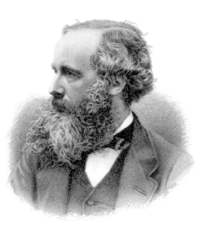Lecture 1.
|
Instructor
|
Teaching Assistants:
|
Contents
Basic Principle of Electromagnetic Theory
Electromagnetic theory forms the foundation of different physical fields and phenomenon. It is used to explain many wave phenomena like propagation, reflection, refraction, diffraction and scattering. In the following, we shall review the fundamental aspects of the electromagnetic theory.
Maxwell's Equations
The physics of electromagnetic field is described mathematically by the Maxwell's equations. These equations can be written in differential as well as integral forms. For time-varying electromagnetic fields, the Maxwell's equations are as follows.
Differential Form
[math]\nabla\times\vec{H}(\vec{r},t)=\vec{J}(\vec{r},t)+\frac{\partial D(\vec{r},t)}{\partial t}[/math]
Ampere's law,
[math]\nabla\times\vec{E}(\vec{r},t)=-\frac{\partial \vec{B}(\vec{r},t)}{\partial t}[/math]
Faraday's law,
[math]\nabla\cdot\vec{B}(\vec{r},t)=0[/math]
Gauss's law (magnetic),
[math]\nabla\cdot\vec{D}(\vec{r},t)=\rho(\vec{r},t)[/math]
Gauss's law (electric),
where:
- [math]\vec{H}(\vec{r},t)[/math] is magnetic field intensity in [A/m];
- [math]\vec{E}(\vec{r},t)[/math] is electric field intensity in [V/m];
- [math]\vec{B}(\vec{r},t)[/math] is magnetic flux density in [Wb/m[math]^2[/math]];
- [math]\vec{D}(\vec{r},t)[/math] is electric flux density in [C/m[math]^2[/math]];
- [math]\vec{J}(\vec{r},t)[/math] is electric current density in [A/m[math]^2[/math]];
- [math]\rho(\vec{r},t)[/math] is electric charge density in [C/m[math]^3[/math]].
The field quantities are depending on space [math]\vec{r}[/math] and on time [math]t[/math], therefore in the following a shorter notation will be left.
There is an important relationship between the variation of the current density [math]\vec{J}[/math] and the charge density [math]\rho[/math], the so-called current continuity equation (also called charge conservation law). This law is coming from the divergence of first Maxwell’s equation:
[math]\nabla\cdot(\nabla\times\vec{H})=\nabla\cdot\biggl(\vec{J}+\frac{\partial D}{\partial t}\biggr)=\nabla\cdot\vec{J}+\frac{\partial}{\partial t}\nabla\cdot\vec{D}[/math].
The left-hand side is equal to zero according to the identity [math]\nabla\cdot(\nabla\times\vec{v})\equiv 0[/math], for any vector [math]\vec{v}=\vec{v}(\vec{r},t)[/math] and the second term on the right-hand side can be rewritten by applying electric Gauss's law. Finally the current continuity equation has the form
[math]\nabla\cdot\vec{J}+\frac{\partial \rho}{\partial t} = 0[/math].
This equation means that the variation of current and charge distribution according to space and time is dependent on each other.
Integral Form
The integral form of Maxwell's equations can be derived from their differential form by employing Stoke's theorem and Gauss's theorem. The integral form is given by
[math]\oint_{\scriptstyle l}\vec{H}(\vec{r},t)\cdot\text{d}\vec{l}=\int_{\scriptstyle A}\vec{J}(\vec{r},t)\cdot\text{d}\vec{A}+\frac{\partial}{\partial t}\int_{A}\vec{D}(\vec{r},t)\cdot\text{d}\vec{A}[/math]
Ampere's law,
[math]\oint_{l}\vec{E}(\vec{r},t)\cdot\text{d}\vec{l}=-\frac{\partial}{\partial t}\int_{A}\vec{B}(\vec{r},t)\cdot\text{d}\vec{A}[/math]
Faraday's law,
[math]\oint_{\scriptstyle A}\vec{B}(\vec{r},t)\cdot\text{d}\vec{A}=0[/math]
Gauss's law (magnetic),
[math]\oint_{\scriptstyle A}\vec{D}(\vec{r},t)\cdot\text{d}\vec{A} = \int_{\scriptstyle V}\rho(\vec{r},t)\text{d}V[/math]
Gauss's law (electric).
The Maxwell's equations are general and hold for fields with arbitrary time dependence in any medium and at any location.
Constitutive Relations
Equations which describe he relationship between field quatities called constitutive relations. Constitutive relations are generally nonlinear, that is the permeability [math]\mu[/math], the conductivity [math]\sigma[/math] and the permebility [math]\varepsilon[/math] depend on the appropriate field quatities,
- [math]\mu=\mu(\vec{H},\vec{B})[/math],
- [math]\sigma=\sigma(\vec{E},\vec{J})[/math],
- [math]\varepsilon=\varepsilon(\vec{E},\vec{D})[/math].
This can be written in another way,
- [math]\vec{B}=\vec{B}(\vec{H})[/math],
- [math]\vec{J}=\vec{J}(\vec{E})[/math],
- [math]\vec{D}=\vec{D}(\vec{E})[/math],
where [math]\vec{B}(\cdot)[/math], [math]\vec{J}(\cdot)[/math] and [math]\vec{D}(\cdot)[/math] are operators.
If the material properties are independent of space [math]\vec{r}[/math], they are homogenious, otherwise theay are inhomogeneous, [math]\mu=\mu(\vec{r})[/math], [math]\sigma=\sigma(\vec{r})[/math], [math]\varepsilon=\varepsilon(\vec{r})[/math]. Constitutive relations may depend on the frequency of excitation as well, [math]\mu=\mu(f)[/math], [math]\sigma=\sigma(f)[/math], [math]\varepsilon=\varepsilon(f)[/math]. When the constitutive parameters depend on the directions of the applied field, the materials are anisotropic, otherwise they are isotropic. In the anisotropic case the permeability, the conductivity and the permittivity are tensors, [math]\vec{B}=[\mu]\vec{H}[/math], [math]\vec{J}=[\sigma]\vec{E}[/math], [math]\vec{D}=\varepsilon\vec{E}[/math], for example
[math][\mu]=\begin{bmatrix} \mu_{xx} & \mu_{xy} & \mu_{xz} \\ \mu_{yx} & \mu_{yy} & \mu_{yz} \\ \mu_{zx} & \mu_{zy} & \mu_{zz} \end{bmatrix}[/math].
In the most general situation, the constitutive relations depend on all of the above variable, e.g.
[math]\vec{B}=\mathfrak{B}\{\vec{H},\vec{r},f\}[/math].
